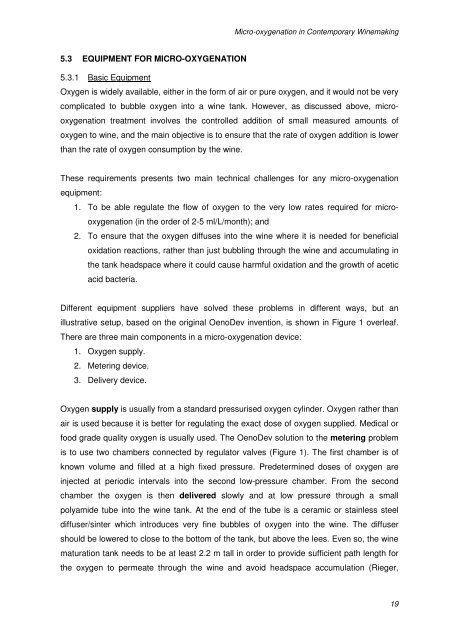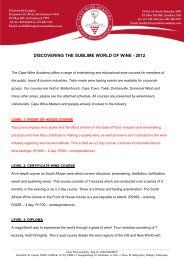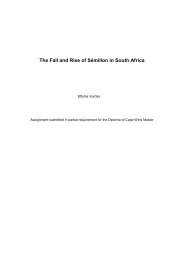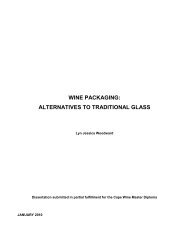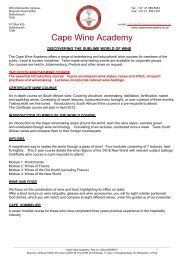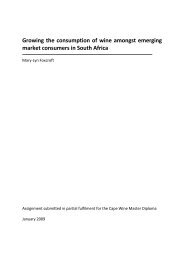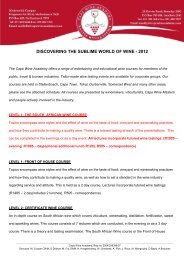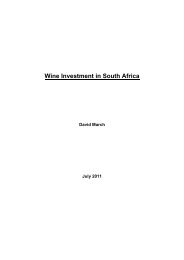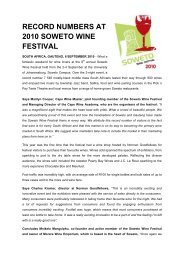Micro-<strong>oxygenation</strong> <strong>in</strong> Contemporary W<strong>in</strong>emak<strong>in</strong>g2006). Whether these newer applications of <strong>oxygenation</strong> <strong>in</strong> w<strong>in</strong>emak<strong>in</strong>g can still becharacterised as <strong>micro</strong>-<strong>oxygenation</strong> raises difficult def<strong>in</strong>itional issues (see Chapter 2).Micro-<strong>oxygenation</strong> was orig<strong>in</strong>ally developed to improve very tannic varietals such asTannat or Cabernet Sauvignon, and the technique is most widely used <strong>in</strong> regions andappellations where those varietals predom<strong>in</strong>ate. Certa<strong>in</strong>ly, full-bodied tannic w<strong>in</strong>es arebetter candidates for <strong>micro</strong>-<strong>oxygenation</strong>. Th<strong>in</strong>ner, medium- or light-bodied, red w<strong>in</strong>es aremuch more risky and may become harsh and dried out after <strong>micro</strong>-<strong>oxygenation</strong> (Paul,2002). For example, experience with P<strong>in</strong>ot Noir has not been encourag<strong>in</strong>g and thetechnique is not used <strong>in</strong> Burgundy despite its enthusiastic uptake <strong>in</strong> other regions of France(Rieger, 2000). Therefore, <strong>micro</strong>-<strong>oxygenation</strong> is not really promoted as a way of improv<strong>in</strong>gpoor colour alone. V<strong>in</strong>ovation (2001b) warns that low colour risks dryness and recommenda tann<strong>in</strong> to anthocyan<strong>in</strong> ratio of at least 4:1. However, it has also been suggested that<strong>micro</strong>-<strong>oxygenation</strong> would be useful for certa<strong>in</strong> varieties, such as Sangiovese, that arerelatively low <strong>in</strong> colour but high <strong>in</strong> tann<strong>in</strong>s (Rob<strong>in</strong>son, 2006).However, very tannic w<strong>in</strong>es are conf<strong>in</strong>ed to specific appellations such as Madiran or arethe result of faulty viticulture (pick<strong>in</strong>g grapes too early or from virus-<strong>in</strong>fected w<strong>in</strong>es). Inpractice, the most widespread use of <strong>micro</strong>-<strong>oxygenation</strong> is as a cheaper alternative tobarrel-age<strong>in</strong>g for medium-quality w<strong>in</strong>es <strong>in</strong>tended for short to medium-term consumption(Paul and Gore, 2006; Goldfarb, 2007). In us<strong>in</strong>g <strong>micro</strong>-<strong>oxygenation</strong> for this purpose thereare a number of choices to be made (Table 3). Micro-<strong>oxygenation</strong> can be applied beforemalolactic fermentation (MLF), after MLF or both. This will also obviously <strong>in</strong>fluence thedose and duration of <strong>micro</strong>-<strong>oxygenation</strong> treatment. Unfortunately there are no clear rules tohelp the <strong>micro</strong>-<strong>oxygenation</strong> beg<strong>in</strong>ner but these decisions are discussed <strong>in</strong> more detail <strong>in</strong>Section 5.4.3. If the objective is to mimic barrel age<strong>in</strong>g <strong>in</strong> sta<strong>in</strong>less steel tanks thenalternative oak products such as segments, staves, or chips may be added concurrentlywith <strong>micro</strong>-<strong>oxygenation</strong> (McCord, 2003; Gore, 2007; Bowyer and McCord, 2007).Although the proponents of <strong>micro</strong>-<strong>oxygenation</strong> claim that the technique should not berelegated to medium-quality w<strong>in</strong>es (V<strong>in</strong>ovation, 2001b), many producers currently use itexclusively for this end of the market, and it is very unlikely that <strong>micro</strong>-<strong>oxygenation</strong> will everreplace traditional long-term maturation <strong>in</strong> new oak barrels for premium quality w<strong>in</strong>es (Paul,2002). However, the future may see comb<strong>in</strong>ation therapy for quality w<strong>in</strong>es. Newer <strong>micro</strong><strong>oxygenation</strong>products allow <strong>micro</strong>-<strong>oxygenation</strong> <strong>in</strong> barrel (Memstar, 2008) and there havebeen some trials on us<strong>in</strong>g <strong>micro</strong>-<strong>oxygenation</strong> before normal barrel age<strong>in</strong>g (Sart<strong>in</strong>i et al.,2007; Ortega-Herás et al., 2008).18
Micro-<strong>oxygenation</strong> <strong>in</strong> Contemporary W<strong>in</strong>emak<strong>in</strong>g5.3 EQUIPMENT FOR MICRO-OXYGENATION5.3.1 Basic EquipmentOxygen is widely available, either <strong>in</strong> the form of air or pure oxygen, and it would not be verycomplicated to bubble oxygen <strong>in</strong>to a w<strong>in</strong>e tank. However, as discussed above, <strong>micro</strong><strong>oxygenation</strong>treatment <strong>in</strong>volves the controlled addition of small measured amounts ofoxygen to w<strong>in</strong>e, and the ma<strong>in</strong> objective is to ensure that the rate of oxygen addition is lowerthan the rate of oxygen consumption by the w<strong>in</strong>e.These requirements presents two ma<strong>in</strong> technical challenges for any <strong>micro</strong>-<strong>oxygenation</strong>equipment:1. To be able regulate the flow of oxygen to the very low rates required for <strong>micro</strong><strong>oxygenation</strong>(<strong>in</strong> the order of 2-5 ml/L/month); and2. To ensure that the oxygen diffuses <strong>in</strong>to the w<strong>in</strong>e where it is needed for beneficialoxidation reactions, rather than just bubbl<strong>in</strong>g through the w<strong>in</strong>e and accumulat<strong>in</strong>g <strong>in</strong>the tank headspace where it could cause harmful oxidation and the growth of aceticacid bacteria.Different equipment suppliers have solved these problems <strong>in</strong> different ways, but anillustrative setup, based on the orig<strong>in</strong>al OenoDev <strong>in</strong>vention, is shown <strong>in</strong> Figure 1 overleaf.There are three ma<strong>in</strong> components <strong>in</strong> a <strong>micro</strong>-<strong>oxygenation</strong> device:1. Oxygen supply.2. Meter<strong>in</strong>g device.3. Delivery device.Oxygen supply is usually from a standard pressurised oxygen cyl<strong>in</strong>der. Oxygen rather thanair is used because it is better for regulat<strong>in</strong>g the exact dose of oxygen supplied. Medical orfood grade quality oxygen is usually used. The OenoDev solution to the meter<strong>in</strong>g problemis to use two chambers connected by regulator valves (Figure 1). The first chamber is ofknown volume and filled at a high fixed pressure. Predeterm<strong>in</strong>ed doses of oxygen are<strong>in</strong>jected at periodic <strong>in</strong>tervals <strong>in</strong>to the second low-pressure chamber. From the secondchamber the oxygen is then delivered slowly and at low pressure through a smallpolyamide tube <strong>in</strong>to the w<strong>in</strong>e tank. At the end of the tube is a ceramic or sta<strong>in</strong>less steeldiffuser/s<strong>in</strong>ter which <strong>in</strong>troduces very f<strong>in</strong>e bubbles of oxygen <strong>in</strong>to the w<strong>in</strong>e. The diffusershould be lowered to close to the bottom of the tank, but above the lees. Even so, the w<strong>in</strong>ematuration tank needs to be at least 2.2 m tall <strong>in</strong> order to provide sufficient path length forthe oxygen to permeate through the w<strong>in</strong>e and avoid headspace accumulation (Rieger,19


